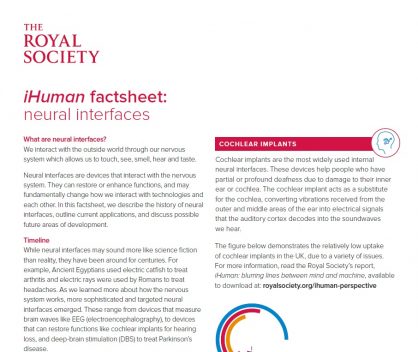The recent release of the iHuman report on neural interfaces by the Royal Society has the potential to elegantly link many aspects of a school’s curriculum at all abilities.

In a fast changing world, which is becoming increasingly dependent on technology, how on earth do we inspire pupils (or staff) to research fast moving topics that may well become obsolete within less than a decade?
Even if it is only a passing mention, I think it is incumbent on us as teachers to help our students be aware of the changing technology in the world around them, not just the tried and tested knowledge that they find in textbooks. This helps prepare them to be flexible for whatever the future of work might bring.
The recent release of the iHuman report on neural interfaces – devices that interact with the nervous system of an individual – by the Royal Society is just such a technology, and has the potential to elegantly link many aspects of a school’s curriculum at all abilities.

As part of the report launch, the Society has produced a useful 3 minute animation, introducing what neural interfaces are and how they are and can be used. This on its own is a great introduction to this rapidly developing area of technology, but it’s content can also be brought into other areas of the curriculum.
Key stage 3 there are lots of links to the curriculum. Design Technology: make a model brain; Science: electricity: Add lighting circuits to show different areas of the brain, and areas affected by different conditions. Also to illustrate how Neural Interface devices may be employed; Biology: the human endocine system (control of glucose), the brain, and the role of Neuroscientists and MRI scanners in mapping regions of the brain to particular functions are also covered by some exam boards.
At GCSE you can bring neural interfaces into biology (central nervous system), philosophy and ethics (the matrix, and the use of technology for good or for ill), English literature (George Orwell: 1984; Frankenstein) and I am sure many more.
At A-level neural interfaces links very closely with aspects of the psychology (decision making and responsibility), biology (nerve conduction, synaptic transmission) and physics (medical imaging) curriculum content. The iHuman report is quite large, but both it and the animation have some really useful, easy to access, examples of neural interfaces that could be used by teachers.
Here at Boroughbridge High school I will be linking neural interfaces into a neurology project my students are currently investigating. As part of the project I have also arranged for my A level pupils to meet with a local neurology consultant to start looking not only at brain structure and function, but also what happens when this goes wrong. This will lead us towards looking at various imaging techniques to assist in the diagnosis of neurological conditions and also possible treatments: current and proposed (this is where the neural interfaces will come in). In the lower school we are going to make a large wire mesh model of the brain and attempt to connect lighting circuits to identify different areas of the brain, and also areas affected by different conditions such as epilepsy. This project will be utilising their scientific research and knowledge alongside developing their literacy, numeracy, communication, team work and creative skills.
You don’t have to go to these lengths to include neural interfaces in your lessons, but I hope you will spend a few minutes watching the animation, and let your students know about this fascinating area.
UPDATE:
You can now find two useful factsheets on the Society’s resource page for teachers, summarising the basics of neural interfaces and the ethical considerations.


